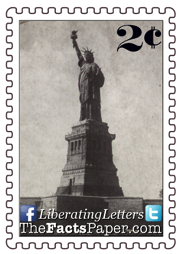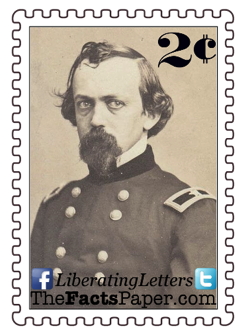October 28, 2016
Dear Liberty,
Charles Pomeroy Stone faced a decision. During the Civil War years earlier, the government made him a scapegoat, wrongly imprisoned him, betrayed his loyalty, and ruined his military career. Now they were knocking at his door, desperately needing his help. He could seek revenge for the way he had been treated, or he could turn the other cheek and once again answer the call of duty to serve the country he so dearly loved.
Stone's first national call to action came even before Abraham Lincoln was officially President. Seven states had already seceded with many more discussing it. (see Sibling Rivalry) Lincoln's trip to Washington for his inauguration would involve several stops, including one in Baltimore. Maryland was a slave state and Lincoln was not popular there, especially in Baltimore. Stone, Inspector General of the District of Columbia Militia, heard of an assassination plot in the city. He worked with Allen Pinkerton to slip Lincoln through the city and into the capital unharmed.
Personally responsible for Lincoln’s security on inauguration day, Stone placed 50 undercover armed men, including snipers, among the attendees, ready for any attack on Lincoln. Placing himself directly next to the president’s carriage, he was honored to protect the first Republican President, Abraham Lincoln, even though he was a Democrat.
After Virginia seceded on April 17th, Lincoln took action to hold the country together. For the South, the war was about state’s rights and keeping slavery. (see Constituting Slavery) For the North and the new anti-slavery Republican Party, it was about emancipation and unity.
For Lincoln, as the president of all states, he had to be sensitive to all arguments. If he leaned too much to the abolitionists' side, he could lose Border States such as Maryland and Kentucky, who owned slaves but were still part of the Union. Lincoln needed those states to remain if there was any hope of keeping the country together. If he was too sympathetic to slave states, his own party would revolt against him.
By the fall, Stone was a brigadier general commanding the 20th Massachusetts Infantry on the Potomac River. When two runaway slaves approached the outfit, Stone ordered their prompt return. Many of the soldiers in the regiment were abolitionists. They were horrified by the incident. Word reached Senator Charles Sumner who strongly condemned Stone on the U.S. Senate floor. (see The Birth Of A Movement) Even though he was a slavery sympathizer and Democrat because of it, Stone was actually complying with federal and state law. Defying it could cause Marylanders to secede, putting Lincoln in an unwinnable position to hold the Union together.
On October 20, 1861, Major General George B. McClellan ordered Stone to do a reconnaissance mission near Leesburg, Virginia. As part of that event, Stone sent Colonel Edward Dickinson Baker to assess the situation. He was to decide whether to withdraw troops already there or send more over. Baker received word of a few skirmishes with the Confederates and called for more troops. With the flood of soldiers, it took them four hours to cross the Potomac River and climb Ball’s Bluff. The Union soldiers quickly found themselves trapped between an unstoppable enemy and a virtually impassible Potomac River at their back.
When the fighting was done, over 1000 Union soldiers were wounded, drowned, captured, or killed, including Col. Baker. Only 160 Confederates were lost. It was a devastating defeat.
Baker was not just any colonel. He was also a Republican U.S. Senator, the only senator to ever die in battle. To top it off, Baker was a very close friend of President Lincoln. In fact, Lincoln had named his second son after Baker. His loss was devastating to Washington DC.
Discouraged by Lincoln’s war leadership, the U.S. Congress formed the Joint Committee on the Conduct of War in December to oversee the war efforts. They needed someone to blame for the senator’s death and that person was Stone. Even though General McClellan reported, "The disaster was caused by errors committed by the immediate Commander (Baker)—not General Stone,” it didn’t matter. Especially since McClellan was also a Democrat.
Led by Sen. Sumner, the committee accused Stone of communicating frequently and improperly with Confederates. They also accused Stone of not sending reinforcements. Finally, they questioned Stone’s loyalty to the Union since he returned escaped slaves and protected slaveholder property even though it was state and federal law to do so. McClellan covered his involvement by placing Stone under a gag order, leaving Stone virtually defenseless.
Stone was arrested just after midnight on February 8, 1862. He was shipped to Fort Lafayette where Confederate sympathizes were sent. As a proud Union officer, Stone was furious. They even made him pay his own train fare to get there. He was placed in solitary confinement until health reasons forced him to be moved to Fort Hamilton. In all, Stone served six months in prison without formal charges or a trial. He was eventually released under a newly signed Article of War that required proper charges to have been filed.
Stone returned to Washington and awaited orders. Secretary of War Edwin M. Stanton refused to assign Stone to any position of authority even though commanding officers requested his services. His military career stalled, even after the senate committee prepared a report clearing Stone of any wrongdoing. Stone resigned his commission on September 13, 1864.
In 1870, Stone was working as a mining engineer when General William T. Sherman recommended he lend his services to the Egyptian Army. (see Sibling Rivalry and Antifa Of The Civil War) For 12 years Stone helped rebuild Egypt’s army. He also led several surveys and expeditions around the Nile River and surrounding area. When the British overtook Egypt in late 1882, Stone packed up his family and came home where he returned to engineering.
At this same time, America was receiving a statue representing freedom and democracy from France. Edouard de Laboulaye, the man who suggested the gift, wanted to celebrate America's victory in the Revolutionary War and her abolition of slavery. Entitled “Liberty Enlightening the World,” the statue was to be placed in New York Harbor. The agreement was that France would fund and built the statue, but America needed to fund and build the pedestal.
When America opened the statue's assembling instructions, they were, of course, in French. They needed a man who could both construct a pedestal and read French. Not only had Stone spent 18 months in Europe around 1849 where he learned French, he just returned from Egypt where he used that French for over a decade. He also had years of engineering experience.
After shunning Stone in the Civil War, America now needed his help. There are several levels of irony here. The man who was wrongly imprisoned by the U.S. Congress because he sympathized with slave owners was now asked to work on a statue celebrating the termination of slavery. Stone, to his credit, had forgiven long ago and gladly accepted the offer.
France’s initial intent was for the statue to be erected for America’s 100th birthday. They missed by ten years. Stone started constructing the pedestal in 1883. There were several obstacles, including running out of funds, but the entire project was finished three years later. Stone did such an amazing job that after its completion, many quipped, “the island would have to be overturned to dislodge the monument from its setting.”
The Statue of Liberty was dedicated on October 28, 1886. Stone served as the Grand Marshal of the statue’s dedication parade. He died three months later on January 24, 1887, in New York City, from pneumonia. Stone was buried with full military honors at West Point where he had graduated 7th in his class in 1845.
Liberty, sometimes even when we try to do everything right, life doesn’t seem to cooperate. When Joseph’s brothers threw him in the pit and sold him to Arabs, his future did not look promising. But he continued to do the right thing and rose to second in power only to the pharaoh. God used his exile to Egypt to save Israel from famine and death.
Stone had every right to become bitter but he continued to do the right thing as well. Stone may have lost his military career, but he had the privilege of being involved in the most important structure representing America. Even if Joseph’s and Stone’s lives had not ended as positively as they did, it is never wrong to do the right thing.
The Statue of Liberty represents freedom and liberty to people all across the world. At the beginning of the 20th century, she was the first thing most immigrants saw when they came to America. (see Coming To America) Her light gave the world hope and a promise of a better life.
God calls us all to “enlighten the world” with the Gospel of
Jesus Christ. He is the light and His grace is the liberty that
gives all humanity true freedom from sin and grants us eternal
life.
Everything that happened to Stone, good and bad, led him
to be the one America needed for such an important project. We
never know when God will use us so you must always shine “this
little light” of yours. You never know what ray of hope it will
bring to a dark world.
That’s my 2 cents.
Love,
Mom
LIBERTY ENLIGHTENING THE WORLD




